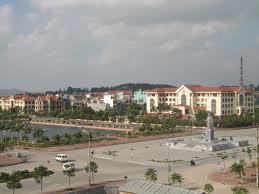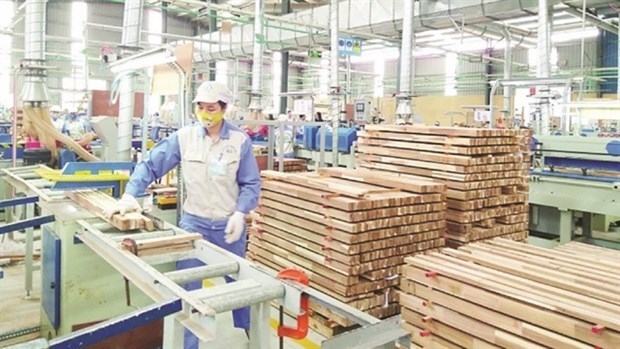Bac Ninh province
Wednesday, April 20,2022
AsemconnectVietnam - To continue to develop Bac Ninh province with high speed but sustainable, efficient and economic restructuring in direction of modern to promote comparative advantage of geographical location and human resources of the province
1.Continue to develop Bac Ninh province with high speed but sustainable, efficient and economic restructuring in direction of modern to promote comparative advantage of geographical location and human resources of the province.
2. Economy must develop dynamic, flexible and effective in accordance with market economy, international economic integration and international competition.
3. Socio - economic development of Bac Ninh province places in close cooperation and relationship with the provinces in northern key economic region and red river delta, especially capital of Hanoi.
5. Incorporate between economic development and national defense, strengthen political system and build strong and effective administration.
II. Development objectives
1. Overall objectives:
Quickly build Bac Ninh achieving goal to become an industrial province in 2020 with a system of relatively modern and synchronous socio-economic infrastructure, closely associate with infrastructure system of Hanoi region. Become a center of training human resources and high quality health care of the region. Develop culture healthy, modern and national character charming.
2. Specific objectives:
2.1. Economic development:
In a period of 2016-2020 economic growth rate is 12% per year, out of which: industry-construction will increases on average 12% per year, service sector rises by 14-15% per year.
State budget collection in the province in 2015 reaches VND 6,200 billion, up 25% on average per year. State budget per GDP is 15% in 2015 and 15.5% in 2020.
2.2. Society development:
Improve quality of workforce, creating jobs; reduc urban unemployment rate from current 4.5% to under 4% and increase percentage of labor used time in rural area to approximately 88-90% in 2020.
Annually, creating jobs for about 22,000-24,000 workers, moving up social labor structure in direction of reducing proportion of employees in agricultural sector, by 2015, rate of workers in agricultural sector is around 42.8%.
In 2015, to strive to complete basically univerlization of education of high school, 100% of schools are solidified; preserve and promote traditional cultural values. Promote mass sport movement and high achievement sport.
By 2020, urbanization rate reaches at least about 45-50%, percentage of non-agricultural labor in total labor force is about 70%.
Percentage of trained labor will be around 39-40% by 2015, 50-60% by 2020. By 2015, 80% of labourers have jobs after training. By 2020, reduce rate of poverty household to below 7% (under standard by 2005).
Rate of malnourished children under 5 age decreases to below 20% by 2015.
3. Environmental protection
Environment is maintained, strive to have no pollution in traditional village. By 2020 about 98% of the population use clean water, collect and process 100% of household waste; manage and process 100% of hazardous industrial waste, medical waste.
Conserve and rationally use natural resources, protect biodiversity, cultural heritage are conserved and restorated .
1. Industry-handicraft
Try to maintain high industrial economic growth, while creating strong changes in quality, efficiency and enhance competitiveness of Bac Ninh province’s industrial products through investment in innovating technological equipment . Increasing proportion of industry and services in the province's GDP strucuture, create conditions for deeper integration in regional and the world economy, bringing Bac Ninh province to become industrial province in 2015.
Prioritize to develop high technology industries, auxiliary industry, mechanical engineering and at the same time, strongly develop advantage group of local raw materials, capable of rapid recovery of capital, have a chance to select investment partners from outside. Focus on developing industries using local raw materials especially raw materials from agriculture and forestry, traditional careers such as fine art pottery, food processing, construction materials industry, garment and textile industry and leather shoes ...
Outputs are mainly traditional industrial products and it forecasts that in the coming years it will have high-tech electronic products of Canon ( investment capital of $ 50 million), projects of producing pharmaceutical products will participate in value of industry.
In coming years, focus on building and improving infrastructure in approved industrial zones and at the same time, improve and develop 25 traditional villages industrial zones and existing small and medium industrial complexes. By 2015, an area of concentrated industrial zone is about 3,190.7 ha; planed area for expanding traditional village industrial zones, industrial complexes is 1,780.2 ha. It is estimated that in 2020 the projects will basically complete, 100% of total area will be filled, production capacity in the industrial zones will be raised.
After 2020, it is expected to plan nearly 118.5 hectares of land for industrial investment projects in 8 districts and city of the province.
2. Service
Develop trade in both domestic and export markets, in urban and rural areas. It is expected that average growth rate of export goods in a period 2015-2020 average growth rate is 18-20% per year, by 2020 exports reaches approximately $ 2 - 2.2 billion.
Tourism development in Bac Ninh province is mainly cultural development. It is expected that in a period 2015-2020, it invests in Co Me love duet cultural tourism zone, Den Dam cultural tourism zone, promote tourism activities, annual growth rate reaches 16-17%. In following periods, due to a number of completed investment projects, a number of amusement parks, sports are formed, increased travel demand incompliance with living standard so annual growth rate for a period of 2015-2020 is expected to reach 15-16%.
Promoting adjacent position to Hanoi, focus on strongly developing services such as technical innovation services, legal services, telecommunication information services, transportation, technology transfer, cultural and recreation services, weekend holiday ... Cooperate with Hanoi to strongly develop financial and banking services , insurance services, trade and scientific and technological services ... Continue improving quality of activities in the of services to meet production , urbanization and living needs, increase contributions to GDP growth.
3. Agriculture, forestry and fishery
For agriculture of Bac Ninh province, focus on developing high-tech agriculture, high economic value and high commodity value, over 60%. Continue investment to promote agricultural production and rural economy restructure towards producing quality and efficiency agricultural products, linking production to markets in Hanoi and other urban areas, Bac Ninh's industrial zones, while taking into account international market for export of high value agricultural products through Noi Bai international airport to enhance using efficient of resources (land, labor and capital .)
Raise production value per unit of arable land, in 2015 increase by 2 fold-times in 2005, in 2020 more than 2 times in 2015. Agriculture continue to grow and develop, promote industrialization of agriculture, and improve lives of agricultural workers on basis of improving productivity of agricultural labor in 2015 more than 2.5 fold-times in 2005 and in 2020 1.5 fold-times in 2015.
4. Social sectors
Paying attention to facilities for education and training, health, cultural information, gymnastics and sports and other social sectors. To promote socialization of the above areas.
5. Infrastructure
Renovate and upgrade external transportation network system to increase trade exchange between Bac Ninh provinces and Ha Noi and other provinces in the northern region. Attach importance to build new roads connecting with national roads, creating new economic axis, space for industry and urban development.
Give priority investment in fields of electricity supply, post and telecommunications, water supply, sanitation.
I. Major development measures, mechanisms and policies
1. Mobilizing investment capital:
It is estimated that capital investment needs about VND 279.696 billion in a period of 2016 - 2020 billion (price in 2005).
2. Stepping up investment promotion and measure of searching and expanding product markets (domestic and export).
4. There are policies to attract, use and train, develop human resource to meet requirements of new phase.
5. Strengthen research and application of scientific achievements and high technologies in production and life.
6. There are appropriate measures to encourage and support non-State -owned economy
7. Continue implementing administrative reform in order to create the best conditions for all economic sectors to participate in development investment.
After approval of plan, it needs to make public, attract attentionof the people, of domestic and foreign investors to participate mobilization to implement the plan. At the same time, regular research, adjust, add the plan timely to suit practical situation.
Deploy plan through plans on socio-economic development 5 years and annually. Annual plan must adhere approved plan objectives and implementation progress in each period.
Monitoring implementation of investment and development as plan. At the end of each plan period (2015, 2020) organize to evaluate implementation of each plan period, supplement and adjust goals to fit actual situation.
Develop action plans and development programs in each period based on orientation of Bac Ninh province’s overall plan on socio-economic development to 2020. Coordinate with central agencies and other provinces to implement development programs and cooperation for mutual development. Review promulgation of guidelines, development policies of the province in direction of cooperation, strengthening inter-regional relationships to ensure consistency, together development. /.
As of 2011, Que Vo Industrial Park has attracted four foreign projects with total registered capital of $ 530.30 million , 378 domestic projects with total registered capital of VND 1,159 billion. Out of which, there are major corporations in the world such as Canon, Red Sea, Mitac, ..
Currently, concerned units are cooperating in building technical infrastructure for this industrial zone under international standard. Internal roads in industrial zone is asphalting , main axis road are 34m wide, 21.5 meters, secondary axis road are 21.5 m. Separate 110KV high-voltage electric station and 22KV line to serve its own electricity demands of businesses in the zone. There is a sewage treatment plant, reaching international standards with a capacity 2,500m3/ day and night. Together, communication systems, banking services, credits are investing synchronized.
4. Yen Phong I Urban and Industrial Zone
Total area of the wholly zone is 840.73 ha. Out of which: Industrial zone is 640.73 ha and urban zone is 200 ha
Adjacent to national road 18 (connecting Noi Bai international airport - Ha Long city), 30 km from Hanoi, 18 km from Noi Bai international airport, 122 km from Cai Lan port (Quang Ninh province), 112 km from Hai Phong Port - this is a favorable place for investors to move and transport and exchange goods with the outside.
Now, the urban and industrial zone is being gradually improved technical infrastructure, meet well requirements of investors.
5.Yen Phong II Urban and Industrial Zone
With convenient locations adjacent to national road 18 ( connecting Noi Bai international airport - Ha Long city); 38 km from Hanoi, 14km from Noi Bai international airport, 135 km from Cai Lan port (Quang Ninh province), 130 km from Hai Phong port.
Currently, the zone is in preparation for construction investment.
6. Nam Son – Hap Linh Industrial Zone
Total area of the area is 1,000 ha, out of which industrial zone is 800 ha, urban zone is 200 ha.
Nam Son – Hap Linh Industrial Zoneis adjacent to national road38, not far from national road 18 ( connecting Noi Bai international airport and Ha Long city, Quang Ninh province), 35 km from centre of Hanoi , 35 km from Noi Bai international airport, 115 km from port of Cai Lan, Lang Son border gate, Hai Phong port.
The zone are planed to invest synchronous technical infrastructure under international standards, ensuring synchronous combination of internal technical infrastructure with outside social infrastructure, forming modern and sustainable development urban – industrial zone.
7. Que Vo II Industrial Zone
Que Vo II Industrial Zone started in March 2008 with a total planned area of 270ha.
Currently, entire system of technical infrastructure of the industrial zones are assigned to Vietnam Urban and Industrial Zone Development Investment Corporation (IDICO) under the Ministry of Construction to undertake.
8. Thuan Thanh I industrial zone
Area: 200ha
Adjacent to national road 38; 40 km from centre of Hanoi capital city, about 50 km from Noi Bai Airport; about 150 km from Cai Lan port (Halong City), about 150 km from border gate Lang Son, about 80 km from Hai Phong port.
Industrial zone will be invested synchronous technical infrastructure to ensure sustainable development of the zone
Dai Kim Industrial Zone locates in eastern Bac Ninh city, near national road 1A and national road 18, adjacent to Cau river port, 34 km from Hanoi, 35 km Noi Bai international airport; 110 km from Cai Lan port (Quang Ninh province), 105 km from Hai Phong port
Dai Kim Industrial Zone is planned for synchronous construction under international standards including industrial zone, residential zone and commercial zone. This is a high-tech complex, associated with perfect urban, commerce and service, in order to to attract high-technology projects, research –development (RD) projects of large domestic and foreign economic groups.
10. Urban industrial zone VSIP Bac Ninh:
VISP urbanIndustrial zone held groundbreaking ceremony in December 2007, with an area of 700 ha. Out of which, 500 ha will be devoted to develop an clean industrial zone, used advanced technology, meet environmental standards. The rest is urban zone with an area of 200ha, including commercial projects, hotels, supermarkets, schools, houses, offices ... with high quality, but will also spend a part of area to develop housing for workers with moderate incomes.
As expected, the project will attract 200 investors with total investments of over $ 2 billion, creating jobs for a total of 40,000 workers. Land area of project are 700 ha, being considered as a very favorable position, adjacent to national road 1A and just 16 km from centre of Hanoi, 39 km from Noi Bai International Airport and 100 km from Hai Phong port, 125 km from Cai Lan port (Quang Ninh) 125 km and very close to provincial road 295 connecting with Chinese border
- Natural resources
- Population and human resources
Waterway
Bac Ninh having three major rivers flows through: Cau river 70 km long, Duong River 42 km and Thai Binh river 17km. All three rivers are likely to allow waterway means of 200 to 400 tons go through and having three major ports in Dap Cau – Cau river.
Hanoi - Lang Son railway running through territory of Bac Ninh province is near 20km long with 4 stations (Tu Son, Lim, Bac Ninh, Thi Cau).
Including irrigation system of north Duong and south Duong, fulfill task of irrigation for people’s living and agricultural production for 8 districts of Bac Ninh province and a part of provinces: Hanoi, Hung Yen and Hai Duong.
Telecommunications network upgrade and diversify types of services. The province has eight district post offices, 23 regional post offices and over 118 communal culture post offices. There are 22 electronic switchboard with a capacity of 62,000 telephone numbers. Total number of subscribers in the province reaches 169,000, reaching 17.2 subscribers per 100 people.
Power supply network
Main power supplying for production and consumption is from national grid of 110 kV Dong Anh - Pha Lai, Dong Anh - Bac Giang, line 110 MW Hanoi - Hai Duong. The wholly province have 110 KV line with 120.04 km; 35 KV line with 249.3 km, 0.4 kV line with 3,700 km. Electrical system serve well for all localities in the province.
Source: Vitic/ www.mpi.gov.vn

Plan on implementing Decision No. 327/QD-TTG dated March ...
Concretize viewpoints, objectives, tasks and solutions of the plan in accordance with practical conditions of the locality, associating ...Plan on implementing national environmental protection ...
Implementation plan of marine aquaculture development ...
Program on conservation and development of Vietnamese ...
Plan on improving quality of human resources to 2025 and ...

Efforts taken to turn culinary culture into national ...
The Vietnam Cuisine Culture Association (VCCA) is taking steps to implement a project to build and develop Vietnamese culinary culture ...Vietnamese cuisine making a name for itself with ...
Vietnam advance to next round of AFC U20 Women’s Asian Cup
Cultural tourism and traditional values promoted through ...


